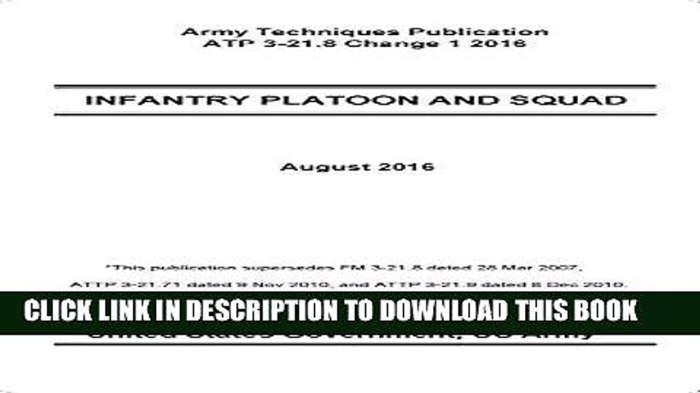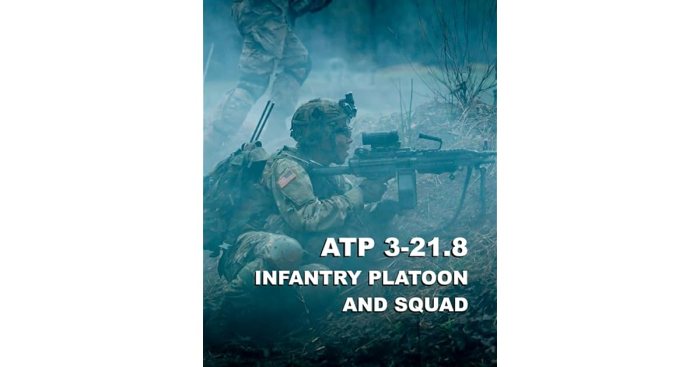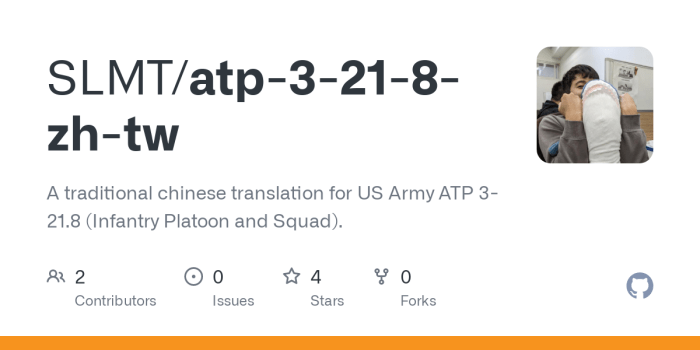ATP 3-21.8 Infantry Platoon and Squad, a comprehensive military doctrine, meticulously Artikels the organizational structure, tactical maneuvers, and operational procedures that govern infantry platoons and squads. This detailed manual serves as an indispensable guide for military personnel, providing a profound understanding of the intricate dynamics and essential functions of these vital combat units.
Throughout this discourse, we will delve into the organizational hierarchy, examining the roles and responsibilities of each position within the platoon. We will explore the fundamental tactics employed by infantry squads, highlighting their formations and maneuvers. Furthermore, we will shed light on the weaponry and equipment utilized by these units, emphasizing their capabilities and limitations.
Infantry Platoon and Squad Organization
An infantry platoon is a tactical unit composed of three or four rifle squads and a headquarters element. The platoon is led by a platoon leader, typically a lieutenant or captain, who is assisted by a platoon sergeant. Each rifle squad consists of nine soldiers: a squad leader, two fire team leaders, and six riflemen.
The platoon headquarters element includes the platoon leader, platoon sergeant, a radio operator, and a medic. The platoon leader is responsible for the overall command and control of the platoon, while the platoon sergeant assists with administrative and logistical matters.
The rifle squads are the primary combat elements of the platoon. Each squad is responsible for a specific sector of the battlefield and is capable of operating independently or as part of a larger formation.
Roles and Responsibilities
- Platoon Leader:Responsible for the overall command and control of the platoon.
- Platoon Sergeant:Assists the platoon leader with administrative and logistical matters.
- Squad Leader:Responsible for the command and control of a rifle squad.
- Fire Team Leader:Responsible for the command and control of a fire team within a rifle squad.
- Rifleman:Provides fire support and security for the squad.
- Radio Operator:Maintains communication with higher headquarters and other units.
- Medic:Provides medical treatment to wounded soldiers.
Chain of Command and Communication
The chain of command within an infantry platoon is as follows:
- Platoon Leader
- Platoon Sergeant
- Squad Leaders
- Fire Team Leaders
- Riflemen
Communication within the platoon is maintained through a variety of means, including radio, hand signals, and messengers.
Squad Tactics and Operations

Infantry squads employ a variety of tactics in combat, including:
- Fire and Maneuver:Squads use fire and maneuver to gain and maintain fire superiority over the enemy.
- Ambush:Squads may set up ambushes to surprise and attack the enemy.
- Raid:Squads may conduct raids to capture or destroy enemy positions or equipment.
- Patrol:Squads may conduct patrols to gather information about the enemy or to secure an area.
Roles and Responsibilities
- Squad Leader:Responsible for the command and control of the squad.
- Fire Team Leader:Responsible for the command and control of a fire team within the squad.
- Rifleman:Provides fire support and security for the squad.
- Automatic Rifleman:Provides suppressive fire for the squad.
- Grenadier:Provides indirect fire support for the squad.
Common Squad Formations and Maneuvers
- Line Formation:Squad members are arranged in a single line, with the squad leader at the front.
- Column Formation:Squad members are arranged in a single file, with the squad leader at the front.
- Vee Formation:Squad members are arranged in a V-shape, with the squad leader at the point.
- Bounding Overwatch:Squad members move in pairs, with one pair providing fire support while the other pair moves forward.
Weapons and Equipment: Atp 3-21.8 Infantry Platoon And Squad

Infantry platoons and squads are equipped with a variety of weapons and equipment, including:
Weapons, Atp 3-21.8 infantry platoon and squad
- Rifles:The primary weapon of the infantryman is the rifle.
- Automatic Rifles:Automatic rifles provide suppressive fire for the squad.
- Grenade Launchers:Grenade launchers provide indirect fire support for the squad.
- Machine Guns:Machine guns provide sustained fire support for the platoon.
- Anti-Tank Weapons:Anti-tank weapons are used to defeat enemy armored vehicles.
Equipment
- Body Armor:Body armor protects the infantryman from enemy fire.
- Helmet:Helmets protect the infantryman’s head from enemy fire.
- Backpack:Backpacks are used to carry the infantryman’s equipment.
- First Aid Kit:First aid kits are used to treat wounded soldiers.
- Radio:Radios are used to communicate with higher headquarters and other units.
Importance of Proper Maintenance and Training
Proper maintenance and training are essential for the effective use of weapons and equipment. Infantrymen must be trained on how to use and maintain their weapons and equipment in order to be able to use them effectively in combat.
Mission Planning and Execution
The process of planning and executing infantry platoon and squad missions involves the following steps:
- Mission Analysis:The platoon leader analyzes the mission and determines the best course of action.
- Mission Planning:The platoon leader develops a plan for the mission, including the objectives, timeline, and resources required.
- Mission Rehearsal:The platoon rehearses the mission to ensure that all members understand their roles and responsibilities.
- Mission Execution:The platoon executes the mission according to the plan.
- Mission Assessment:The platoon leader assesses the mission and determines whether the objectives were achieved.
Factors to Consider When Planning a Mission
- Enemy Situation:The platoon leader must consider the enemy’s strength, disposition, and tactics.
- Terrain:The platoon leader must consider the terrain and how it will affect the mission.
- Weather:The platoon leader must consider the weather and how it will affect the mission.
- Time:The platoon leader must consider the time available to complete the mission.
- Resources:The platoon leader must consider the resources available to complete the mission.
Types of Missions
- Attack:Platoons and squads may be tasked with attacking enemy positions.
- Defense:Platoons and squads may be tasked with defending friendly positions.
- Patrol:Platoons and squads may be tasked with patrolling an area to gather information or to secure an area.
- Raid:Platoons and squads may be tasked with conducting raids to capture or destroy enemy positions or equipment.
Leadership and Training

Effective leadership is essential for the success of infantry platoons and squads. Infantry leaders must be able to motivate their soldiers, make sound decisions, and lead by example.
Qualities of a Good Infantry Leader
- Courage:Infantry leaders must be courageous and willing to lead their soldiers into combat.
- Competence:Infantry leaders must be competent in their military skills and knowledge.
- Communication Skills:Infantry leaders must be able to communicate effectively with their soldiers and with higher headquarters.
- Decision-Making Skills:Infantry leaders must be able to make sound decisions under pressure.
- Empathy:Infantry leaders must be able to understand and empathize with their soldiers.
Importance of Training and Professional Development
Training and professional development are essential for infantry personnel. Infantry personnel must be trained on a variety of military skills, including:
- Marksmanship:Infantry personnel must be proficient in marksmanship.
- Combat Tactics:Infantry personnel must be trained in combat tactics.
- First Aid:Infantry personnel must be trained in first aid.
- Leadership:Infantry personnel must be trained in leadership.
- Physical Fitness:Infantry personnel must be physically fit.
FAQ Compilation
What is the primary role of an infantry platoon?
Infantry platoons are primarily responsible for conducting ground combat operations, engaging enemy forces in close-quarters combat, and providing security and support for other units.
What are the key principles of squad tactics?
Squad tactics emphasize teamwork, coordination, and the utilization of cover and concealment. Squads employ a variety of formations and maneuvers to maximize their effectiveness in combat.
What are the most common weapons used by infantry platoons and squads?
Infantry platoons and squads typically utilize a combination of rifles, machine guns, grenade launchers, and anti-tank weapons to engage enemy targets.